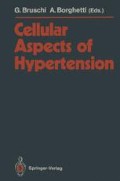Abstract
Investigation of the mode of inheritance of systolic blood pressure as a quantitative trait in families and its distribution in the population has led to two main conclusions: (1) blood pressure is under genetic control and 30%–40% of its variability is determined by the variance in the qenome; (2) there is no single major gene responsible for the variation of blood pressure in a population [1,2]. The variety of clinical forms of primary hypertension suggests a heterogeneity of the disease [3]. This heterogeneity complicates the identification of hereditary factors determining the variability of blood pressure in humans.
Access this chapter
Tax calculation will be finalised at checkout
Purchases are for personal use only
Preview
Unable to display preview. Download preview PDF.
References
Camussi A, Bianchi G (1988) Genetics of essential hypertension from the unimodal-bimodal controversy to molecular tochnology. Hypertension 12: 620–628
Rapp JP (1983) Genetics of experimental and human hypertension. In: Genest J, Kuchel O, Hamet P, Cantin M (eds) Hypertension: physiology and treatment. McGraw-Hill, New York, pp 582–598
Laragh JH (1983) Personal views on the mechanisms of hypertension. In: Genest J, Kuchel O, Hamet P, Cantin M (eds) Hypertension: physiology and treatment. McGraw-Hill, New York, pp 615–631
Yamori Y (1983) Physiology of the various strains of spontaneously hypertensive rats. In: Genest J, Kuchel O, Hamet P, Cantin M (eds) Hypertension: physiology and treatment. McGraw-Hill, New York, pp 556–581
Bianchi G, Ferrari P (1983) Animal models of arterial hypertension. In: Genest J, Kuchel O, Hamet P, Cantin M (eds) Hypertension: physiology and treatment. McGraw-Hill, New York, pp 534–555
Rapp JP (1983) A paradigm for identification of primary genetic causes of hypertension in rats. Hypertension 5 [Suppl I]: I198 - I203
Sing CF, Boerwinkle, E, Turner ST (1988) Genetics of primary hypertension. Clin Exp Hypertens [A] 8: 623–651
Botstein D, White R, Skolnick M, Dawis RW (1980) Construction of genetic linkage map in man using restriction fragment length polymorphism. Am J Hum Genet 32: 314–331
Schlager G, Chang-Shin C (1989) The role of dominance and epistasis in the genetic control of blood pressure in rodent models of hypertension. 6th international symposium on SHR and related studies. Iowa City, p 32
Postnov YV, Orlov SN (1984) Cell membrane alterations as a source of primary hypertension. J Hypertens 2: 1–6
Kotelevtsev YV, Orlov SN, Pokudin NI, Agnayev VM, Postnov YV (1987) Genetic analysis of Na+, K+-cotransport. Cat+ content in erythrocytes and blood pressure in SHR x WKY F2 hybrids (in Russian). Biull Eksp Biol Med 103: 456–458
Orlov SN, Pokudin NI, Postnov YV (1988) Calcium transport in erythrocytes of rats with spontaneous hypertension. J Hypertens 6: 829–837
Postnov YV (1988) Cell membrane alteration in primary hypertension an approach to its explanation. Acta Physiol Scand 133 [Suppl 571]: 175–180
Kotelevtsev YV, Brashishkite DA, Spitkovsky DD, Kiseljov FL, Postnov YV (1988) Interstrain restriction fragment length polymorphism of c-fos and c-src oncogene loci in spontaneously hypertensive and normotensive rats. J Hypertens 6: 779–781
Paterson AH, Lander ES, Hewitt JD, Peterson S, Linkoln S, Tanksley SD (1988) Resolution of quantitative traits into Mendelian factors by using a complete RFLP linkage map. Nature 335: 721–726
Lander ES, Botstein D (1989) Mapping mendelian factors underlying quantitative traits using RFLP linkage maps. Genetics 121 (1): 185–199
Pravenec M, Klir P, Kren V, Zicha J, Kunes J (1989) An analysis of spontaneous hypertension in SHR by means of new recombinant inbred strains. J Hypertens 7 (3): 217–221
Donis-Keller H, Lander ES et al. (1987) A genetic linkage map of the human genome. Cell 51 (2): 313–337
Author information
Authors and Affiliations
Editor information
Editors and Affiliations
Rights and permissions
Copyright information
© 1991 Springer-Verlag Berlin • Heidelberg
About this paper
Cite this paper
Kotelevtsev, Y.V., Postnov, Y.V. (1991). RFLP Study of the SHR Genome in Relation to Cell Membrane Abnormalities. In: Bruschi, G., Borghetti, A. (eds) Cellular Aspects of Hypertension. Springer, Berlin, Heidelberg. https://doi.org/10.1007/978-3-662-00983-3_17
Download citation
DOI: https://doi.org/10.1007/978-3-662-00983-3_17
Publisher Name: Springer, Berlin, Heidelberg
Print ISBN: 978-3-662-00985-7
Online ISBN: 978-3-662-00983-3
eBook Packages: Springer Book Archive

